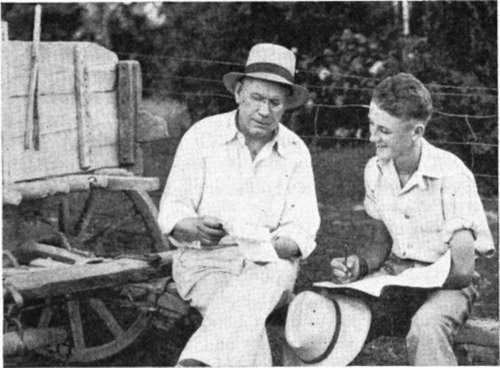Chapter XXXIII. The "Lone" Plan For Cubs And Scouts
Description
This section is from the book "Scouting For Rural Boys. A Manual For Leaders", by Boy scouts of America. See also: Outdoor Adventure Manual: Essential Scouting Skills for the Great Outdoors.
Chapter XXXIII. The "Lone" Plan For Cubs And Scouts
The word "Lone" as used in Lone Scouting does not mean "alone" in the usual sense. It comes nearer to the meaning of the Lone Indian Brave. Similarly the Lone Scout "on his own" reaches out for Scouting values not only for himself, but for his home group and neighborhood.
The Boy Scouts of America has made provision for Cubs, Scouts, Explorers and Rovers on a "Lone" basis, and in every case it brings about group action, and with helpful, inspiring Scouter or man relationships. The genius of Scouting lies in the many helpful ways that boys as Scouts are related to fine men.
While the program activities for these four types of Lone Cub and Scout programs vary in content of program and activities, yet they are alike in the simple direct "method" whereby program activities are made available to the rural boy in the home and neighborhood in which he lives.
The lone boy in Cubbing and Scouting has four men cooperating in his efforts-his "Friend and Counselor," his father or guardian, the Field Commissioner of Lone Scouts, and in most cases the "Tribe" Scoutmaster as well. Most Lone Scouts should eventually unite with other Lone Scouts. In addition, his Scout relationship opens the door to this Lone Scout to counsel with any of the District Scouters and Merit Badge Counselors.
Some Progressive Steps In Lone Scouting
1. While the Lone Scout (or Lone Cub or Lone Explorer or Lone Rover) starts his Scout experience by picking his Lone Scout "Friend and Counselor" and then "wades in" to learn the outdoor and farm and service skills set forth in his Handbook-yet experience has shown that soon something else tends to happen.
2. This Lone Scout has boy friends whom he encourages to become Lone Scouts also-or he meets a young man who already has become a Lone Scout and they meet as frequently as their other duties and their distance apart warrants.
3. If the area is but sparsely populated, they may unite with others, in the district or in the council area, in the building up of a Lone Scout Tribe, which will have an R.F.D.-mail contact and may meet as a Tribe with the Tribe Scoutmaster, at different places over the district and at accessible points, once a month, or as often as distance and duties permit.
4. Frequently one Lone Scout has started, then has come two, then a half dozen, then a dozen and a rural Tribe and Tribe Patrol or a Troop has resulted-all from the start made by one boy in becoming a Lone Scout. One instance of this was in western Iowa, where an alert youngster became a Lone Cub with a Lone Cub "Friend and Counselor." Soon some friends joined him in a "Neighborhood Den." Later, as they grew older, they became Lone Scouts. This group grew into a rural Troop, with the result that the interest stirred up in the community and county by these Scouts and their men friends and leaders led to the formation of a well developed district of the local council-all because one boy had "drive" enough to reach out and begin Lone Cubbing at home.

A BOY-MAN WAGON-TONGUE CONFERENCE-INDIANA
Lone Scouts In The Philippines
During a four-year period the Philippine Boy Scout Council, with over 50% of the council population rural, increased their "outreach" as follows:
1934 | 1935 | 1936 | 1937 | |
Rural troops | 82 | 154 | 212 | 304 |
Scouts in Rural Troops | 1804 | 3815 | 5213 | 7324 |
Lone Scout Tribes | 13 | 12 | 16 | 27 |
Lone Scouts in Tribes | 415 | 504 | 678 | 1047 |
Rural Leaders for the above. | 41 | 119 | 645 | 1324 |
The council made this progress by appointing a splendid man and worker as "Field Commissioner for Lone Scouting." He, in turn, appointed a "District Field Commissioner for Lone Scouting" in each of the districts of the council.
Continue to:


